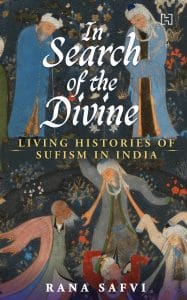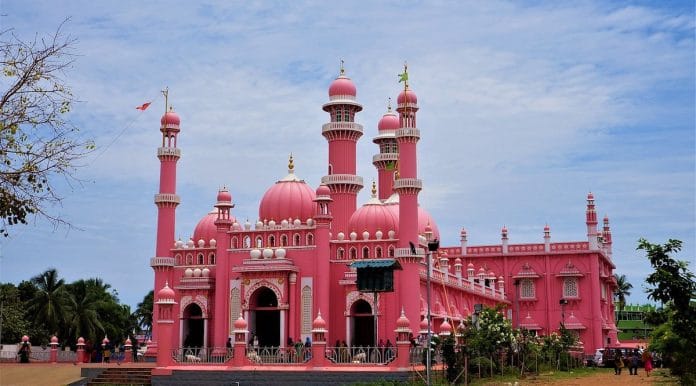Kerala is known to be a very modern state, with advanced literary rates and matrilinear practices followed in its Nair Hindu community. So it should not come as a surprise that the most famous dargah of Kerala is of a female saint.
The Beemapalli Dargah in Thiruvananthapuram is dedicated to Syedunnisa Beema Beevi, also affectionately called Amma, and her son Syed us-Shuhada Maheen Abubacker, who came from Arabia. She is said to be a direct descendant of the Prophet. Not much is known about her, but the fact that she is believed to have arrived in Kerala at the same time as Malik Ibn Deenar (d. 748) – one of the first Muslims to come to India – has no historical evidence. Though the date of her arrival may be suspect, her powers and popularity are not.
Beema Beevi is said to have performed many karamat (miracles), and it is these miraculous powers that drew people of all faiths and caste to come to her. Though not a Sufi, her resting place is called a dargah and she is venerated by many – especially the fishing community.
I contacted Dr Mohammad Ismail in Calicut to find out more. He kindly got in touch with a relative in Thiruvananthapuram, who found out the following information from the dargah committee and relayed to me. Once again there is no historical reference for this information, but as it is an important part of the local cultural and religious experience, I am recording it here. He said:
Beemapalli Dargah Sharif is an important pilgrim centre in Kerala, not only for Muslims but also for Christians as well as Hindus.
This shrine advocates communal harmony and thousands of pilgrims coming from different parts of South India especially from Kerala and Tamil Nadu for the annual festival (uroos/urs) here. Apart from uroos, hundreds of people come rushing to this dargah on a daily basis to offer prayers to cure their diseases, or for thanksgiving. The devotees have a firm belief that this lady saint has miraculous powers to cure diseases, especially mental illnesses. There are hundreds of living examples, according to the dargah administration. One can see many a number of such cured patients in and around, most of whom have been abandoned by relatives and are taken care of by the dargah administration.
Also read: Ajmer Sharif never had to explain itself. It now confronts new world of suspicion, scrutiny
The history of the dargah, in Ismail’s words, is this: Beema Beevi, a descendant of the Prophet, and her son came to Tamil Nadu some three hundred years ago for dawah (preaching Islam), and later settled down in Kerala. She came from a family of hakims (traditional physicians) and the mother-son duo treated and cured many patients, simultaneously preaching Islam. Many people embraced Islam and stayed in and around her place of residence and gradually that place became a Muslim settlement. Ismail says:
As per belief of her followers, some envious local clergy decided to put an end to the increasing popularity of the Beevi and her son. Upon their instigation the local king imposed a heavy tax on them. But Sayyid Maheen Abubakkar refused to pay. He said that since the country belongs to God he would pay it directly to God. This resulted into a conflict, and he was killed in action, becoming a shaheed (martyr). The bereaved mother died on the 41st day of the demise of her son, and both were buried on the same premises.
Thereafter, her devotees have had many miraculous experiences and gradually her tomb became a pilgrim centre. People of all faiths come to offer prayers at Beemapally. The majority who come to pray here are women.
Interestingly, Thiruvananthapuram has two other pilgrim centres which also belong to lady saints/deities; one is Vettukad St. Mary’sChurch, where the Perunnal (annual festival) is very famous, and the other is Attukal Temple, where goddess Parvathy is the principal deity. The Attukal Ponkala (annual festival) here, is purely a women’s festival and is referred to as the Kumbhamela of women.
Beema Beevi’s miracles continue even today. Lawyer Chandrasekhar Tampi told me an interesting story about her. His mother left Kerala in the 1970s when she married his bureaucrat father. Neither he nor his mother were aware of the Beemapalli Dargah. In Tampi’s words:
As a child, living in Kolkata, I would, for a long time, see an apparition of a woman with a child every night standing outside my door. One day, it suddenly stopped.
Many years later, probably… probably in my second year of graduation… I learnt from my grandmother […] that my mom had spoken to her about it, and someone back then had suggested to my grandmother that an offering be made in Beemapalli. My grandmother tells me that it is roughly around the same time that I stopped complaining about the apparitions. To clarify, it is not that I knew that offering was made and hence the apparitions disappeared.
Also read: How India’s coastal Muslims helped it become wealthy, successful economy in medieval era
Thampi doesn’t remember who his grandmother had spoken to, as he was too young then (in the eighth standard), nor whether the offering was subsequently made.
Bema Beevi’s annual urs, called the Chandanakkudam Mahotsavam, attracts huge crowds who come to offer pots, chaddars, sandalwood paste, incense sticks, and oil. The highlight of the festival is the earthen pots (kudams), covered with sandalwood paste and flowers, filled with coins as offerings. The offerings are later distributed as prashad. It is held for 10 days, starting on the first of the Islamic month Jamad ul-Awwal.
The two wells in the compound are also said to have healing powers, and are considered capable of curing any disease. One is said to contain hot water and the other cold; they don’t dry up even in the most severe drought.
A beautiful mosque, with soaring minarets and domes, began to be constructed in 1960 and the construction took 18 years to complete. Govindan Gopalakrishnan, who though not a trained architect, has so far designed around a hundred mosques, including this one, and feels that it is a talent bestowed to him by God. Gopalakrishnan fasts during the months of Ramzan and Lent and takes off for the Sabarimala pilgrimage every year. He keeps copies of the Quran, Gita, and the Bible in his house. The urs ceremony is led by the imam of the mosque. The imam leads the devotees as they do the ‘Pattana Pradakshinam’ (circumambulation of the tomb), and it ends with an Annadanam (feast).
Special buses are deployed in the state to ferry devotees, and a local holiday is declared in Thiruvananthapuram.
The festival is also a time to see several art forms like Daharamuttu (done with a sword) performed within the mosque.
 This excerpt from ‘In Search of the Divine’ by Rana Safvi has been published with permission from Hachette India.
This excerpt from ‘In Search of the Divine’ by Rana Safvi has been published with permission from Hachette India.






